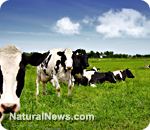Foot and Mouth Disease (FMD)
FOOT-AND-MOUTH DISEASE (FMD, APHTHOUS FEVER)
Synopsis
Foot-and-mouth disease virus, an aphthovirus
Affects ruminants and pigs. Highly contagious, usually low mortality but great economic impact worldwide
Inha lation/ingestion----> oropharyngeal infection----> viremia----> epidermal cells-----> signs and lesions enhanced by mechanical trauma
Fever, profuse salivation, vesicles in mouth and feet, sudden death
in young animals
- Clinical pathology/diagnostic confirmation
Virus isolation, serology and RT-PCR detection. Typing confirmed in a reference laboratory
Vesicular, erosive/ulcerative stomatitis and esophagitis, vesicular/ulcerative dermatitis (feet and teats) and in neonates, interstitial mononuclear and necrotic myocarditis
- Differential diagnostic list
- Vesicular stomatitis
- Vesicular exanthema
- Swine vesicular disease
- Rinderpest
- Bovine viral diarrhea
None except symptomatically.
Mass vaccination with killed vaccines in endemic areas, eradication by slaughter when feasible, and strict quarantine during outbreaks
Read full in book:
A textbook of the diseases of cattle, horses, sheep, pigs and goats












